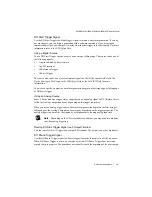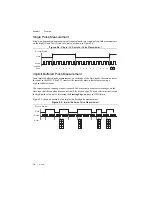
4-8
|
ni.com
Chapter 4
Digital Input/Output and PFI
•
Buffered Change Detection Acquisition
—A buffer is a temporary storage in computer
memory for acquired samples. In a buffered acquisition, data is stored in the cDAQ
controller onboard FIFO then transferred to a PC buffer. Buffered acquisitions typically
allow for much faster transfer rates than nonbuffered acquisitions because data accumulates
and is transferred in blocks, rather than one sample at a time.
Digital Output
To generate digital output, insert a digital output C Series module in any slot on the cDAQ
controller. The generation specifications, such as the number of channels, channel configuration,
update rate, and output range, are determined by the type of C Series module used. For more
information, refer to the documentation included with your C Series module(s).
With parallel digital output modules (formerly known as hardware-timed modules), you can do
multiple software-timed tasks on a single module, as well as mix hardware-timed and
software-timed digital output tasks on a single module. On serial digital output modules,
(formerly known as static digital output modules), you cannot mix hardware-timed and
software-timed tasks, but you can run multiple software-timed tasks.
You may have a hardware-timed task or a software-timed task include channels from multiple
modules, but a hardware-timed task may not include a mix of channels from both parallel and
serial modules.
Digital Output Data Generation Methods
When performing a digital output operation, you either can perform software-timed or
hardware-timed generations. Hardware-timed generations must be buffered.
Software-Timed Generations
With a software-timed generation, software controls the rate at which data is generated. Software
sends a separate command to the hardware to initiate each digital generation. In NI-DAQmx,
software-timed generations are referred to as on-demand timing. Software-timed generations are
also referred to as immediate or static operations. They are typically used for writing out a single
value.
For software-timed generations, if any DO channel on a serial digital module is used in a
hardware-timed task, no channels on that module can be used in a software-timed task.
Hardware-Timed Generations
With a hardware-timed generation, a digital hardware signal controls the rate of the generation.
This signal can be generated internally on the controller or provided externally.
Hardware-timed generations have several advantages over software-timed acquisitions:
•
The time between samples can be much shorter.
•
The timing between samples is deterministic.
•
Hardware-timed acquisitions can use hardware triggering.






























